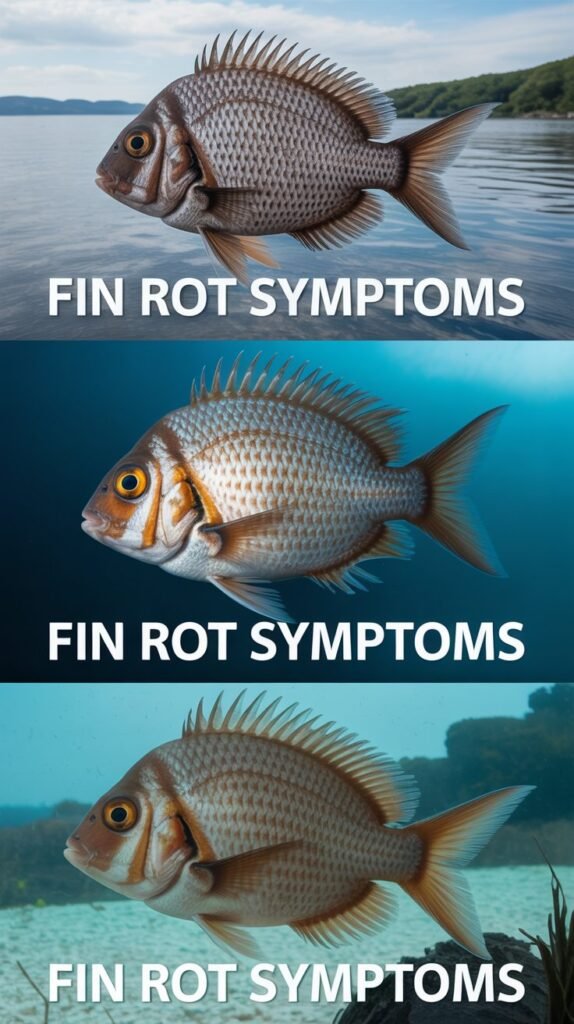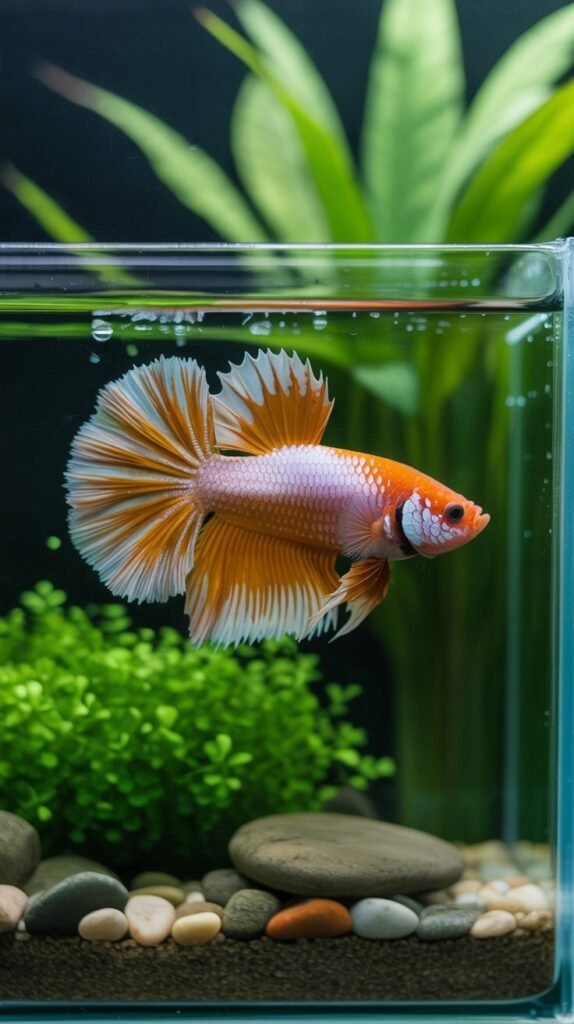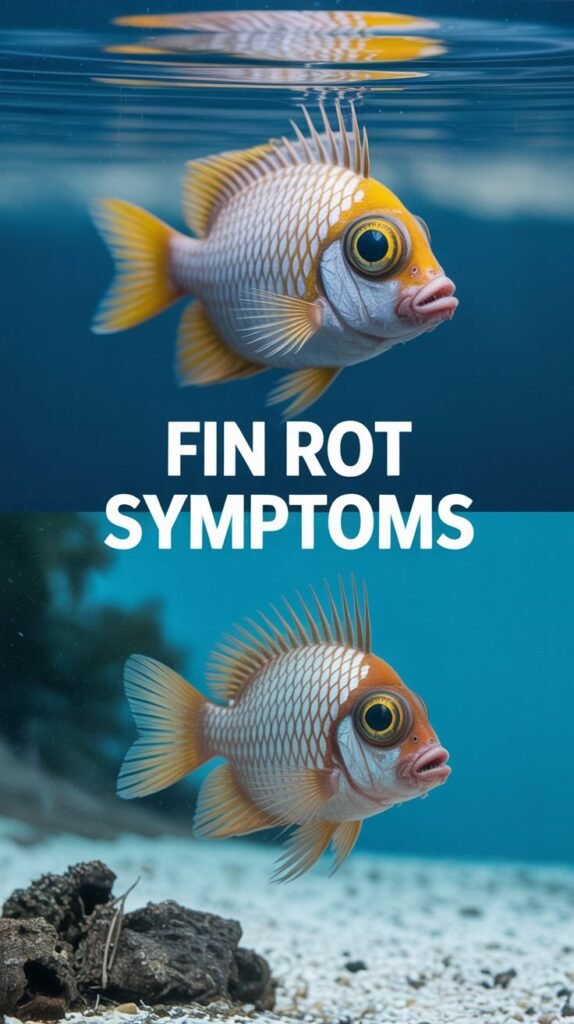Fin rot is one of the most common and frustrating fish diseases faced by aquarium hobbyists. It often affects freshwater and saltwater species alike, especially those kept in community tanks or under stressful conditions. While fin rot is rarely fatal in its earliest stages, it can quickly progress to severe tissue damage, systemic infections, and even death if left untreated.
Recognizing fin rot symptoms early is the most effective way to save your fish and restore the health of your aquarium. This comprehensive guide covers everything you need to know: the signs of fin rot, underlying causes, how to diagnose it correctly, treatment options, and long-term prevention strategies.
What Is Fin Rot?
Fin rot is a bacterial or fungal infection that primarily affects the fins and tail of fish. It is often secondary, meaning it usually develops due to poor water quality, stress, or injuries that weaken the immune system. The condition is characterized by progressive deterioration of the fins, beginning with small frays or discoloration and advancing to complete fin loss if untreated.

Fin rot can be caused by:
- Bacterial infections – usually Aeromonas, Pseudomonas, or Vibrio species.
- Fungal infections – typically appear as cotton-like growths on decaying fin tissue.
- Poor aquarium conditions – such as ammonia spikes, overcrowding, or improper diet.
Understanding and identifying the symptoms of fin rot is crucial to preventing permanent damage.
Early Stage Fin Rot Symptoms
Detecting fin rot early increases the chances of successful treatment. At this stage, the infection is usually mild and reversible.
1. Slight Fraying of Fins
The first sign is often subtle fraying or ragged edges on the fins. This may look like small tears or uneven edges, different from normal wear or nipping by other fish.
2. White or Cloudy Edges
In bacterial fin rot, the infected area may appear white, gray, or milky at the edges of the fin. This is due to bacterial activity breaking down the fin tissue.
3. Black, Brown, or Red Streaks
Discoloration can also occur, particularly at the edges of the fins. Dark streaks or redness often indicate tissue necrosis or blood vessel damage.
4. Loss of Transparency
Healthy fins are usually translucent. In early fin rot, the fins may become opaque or dull, indicating unhealthy tissue.
Moderate Stage Fin Rot Symptoms
If left untreated, fin rot progresses to more noticeable damage. At this point, intervention becomes urgent.
5. Noticeable Shortening of Fins
The fins appear shorter than normal as tissue breaks away. This is often mistaken for aggressive fin nipping, but careful observation will reveal ragged edges rather than clean cuts.
6. Cotton-Like Growth
When fungus is present, you may notice white fluffy patches on the fins. These are fungal colonies feeding on decaying tissue.
7. Lethargy and Stress Behavior
Fish suffering from fin rot may become less active, hide more frequently, or lose interest in food. Stress worsens the infection.
8. Mild Body Lesions
The infection can spread from fins to the skin, body, and tail base, creating small sores or ulcers.
Advanced Stage Fin Rot Symptoms
At this point, the infection is severe and potentially life-threatening.
9. Complete Fin Erosion
The fins may be almost entirely gone, leaving only fin rays or stubs. This makes swimming difficult.
10. Open Wounds and Ulcers
Deep ulcers or bleeding areas may appear where fins once were, exposing the fish to secondary infections.
11. Loss of Appetite
Fish may stop eating altogether, signaling advanced illness and a weakened immune system.
12. Systemic Infection Symptoms
In severe cases, bacteria spread internally, leading to dropsy (swollen abdomen), clamped fins, rapid breathing, or sudden death.
Causes and Risk Factors of Fin Rot

Understanding what causes fin rot helps in both treatment and prevention. The main culprits are:
1. Poor Water Quality
- High ammonia, nitrite, or nitrate levels
- Infrequent water changes
- Overfeeding leading to waste buildup
Poor water quality stresses fish, suppressing immunity and creating a breeding ground for bacteria.
2. Overcrowding
Too many fish in one tank increases waste, aggression, and stress. Fin nipping injuries often develop into infections.
3. Aggressive Tank Mates
Fin rot can be triggered by physical damage from fin-nipping species like barbs, bettas, or tetras.
4. Inadequate Diet
A lack of essential nutrients weakens the immune system, leaving fish more vulnerable to bacterial and fungal infections.
5. Stress Factors
Temperature fluctuations, poor acclimation, or frequent handling weaken fish immunity, paving the way for infections.
6. Secondary Infections
Fish already weakened by parasites (like ich) or other illnesses often develop fin rot.
How to Diagnose Fin Rot Correctly
Because symptoms sometimes overlap with other issues (like aggression or physical injuries), proper diagnosis is key.
- Check tankmates → Are other fish showing similar symptoms?
- Observe edges → Ragged, white, or cottony edges usually indicate infection. Clean cuts suggest nipping.
- Test water parameters → Ammonia and nitrite should always be at 0 ppm. High levels confirm stress as a factor.
- Look for progression → Fin rot worsens over days. Injuries from aggression usually stabilize if fish are separated.
If multiple fish show signs and water quality is poor, fin rot is the most likely diagnosis.
Treatment Options for Fin Rot

Treatment depends on severity. Early cases can often be reversed with improved care, while advanced cases need medication.
1. Improve Water Quality
- Perform 25–50% water changes immediately.
- Vacuum gravel to remove waste.
- Maintain stable temperature (75–82°F for most tropical fish).
- Reduce stocking density.
2. Isolate Infected Fish
Move severely infected fish to a hospital tank. This prevents spread and allows targeted treatment.
3. Salt Baths (Mild Cases)
Aquarium salt can help:
- Add 1 tsp per gallon in a quarantine tank.
- Provides antibacterial and antifungal benefits.
- Do not use with salt-sensitive species (like scaleless catfish).
4. Antibacterial Medications
For bacterial fin rot, use:
- Maracyn, API Furan-2, or Kanaplex.
- Follow dosage carefully to avoid harming beneficial bacteria.
5. Antifungal Treatments
If fungus is present:
- Use methylene blue or aquarium antifungal solutions.
- Combine with antibacterial treatment if infection is mixed.
6. Supportive Care
- Feed high-quality, vitamin-rich foods.
- Reduce stressors like aggressive tankmates.
- Maintain pristine water conditions.
Preventing Fin Rot
Prevention is always easier than cure. Follow these steps to reduce risk:
- Regular Water Changes – Weekly 25–30% water changes keep parameters stable.
- Balanced Diet – Offer a mix of flakes, pellets, frozen, and live foods.
- Avoid Overcrowding – Keep stocking density within recommended limits.
- Quarantine New Fish – Isolate for 2–4 weeks before adding to main tank.
- Tankmate Compatibility – Avoid housing fin-nippers with delicate fish.
- Monitor Water Parameters – Test regularly for ammonia, nitrite, nitrate, and pH.
- Stress Reduction – Keep temperature stable and avoid unnecessary handling.
Commonly Affected Fish Species
While any fish can develop fin rot, some are more prone due to delicate fins or stress susceptibility:
- Betta fish – Long, flowing fins are easy targets for infection.
- Goldfish – Produce large amounts of waste, increasing bacterial growth.
- Tetras & Barbs – Often victims or aggressors in nipping-related infections.
- Guppies & Mollies – Sensitive to water quality fluctuations.
FAQs About Fin Rot Symptoms
1. How do I know if my fish has fin rot or just damaged fins?
Damaged fins from aggression usually have clean, even tears. Fin rot has ragged, uneven edges with discoloration and worsens over time.
2. Can fin rot heal on its own?
In very mild cases, if water quality improves, fins may regenerate. However, most cases need treatment to prevent progression.
3. How long does it take for fin rot to heal?
With proper treatment, early fin rot may improve within a week. Severe cases can take 3–6 weeks for fins to fully regrow.
4. Are fin rot symptoms contagious?
Yes, the bacteria and fungus can spread in poor water conditions. Always isolate infected fish.
5. Can fish die from fin rot?
Yes, if untreated, fin rot can lead to systemic infections and death. Early detection is vital.
6. What do regrowing fins look like?
New fin tissue appears clear or transparent before regaining full coloration.
7. Can I use home remedies for fin rot?
Yes, aquarium salt baths, clean water, and garlic-rich food can help mild cases. Severe infections require medication.
Final Thoughts
Fin rot is a common but preventable fish disease. The key lies in recognizing symptoms early, ensuring clean water, providing a stress-free environment, and acting quickly with treatment when necessary. With good care, most fish can make a full recovery, and their fins can regrow beautifully.
By maintaining proper aquarium practices, you can protect your fish from this painful disease and enjoy a thriving, healthy aquatic environment.

